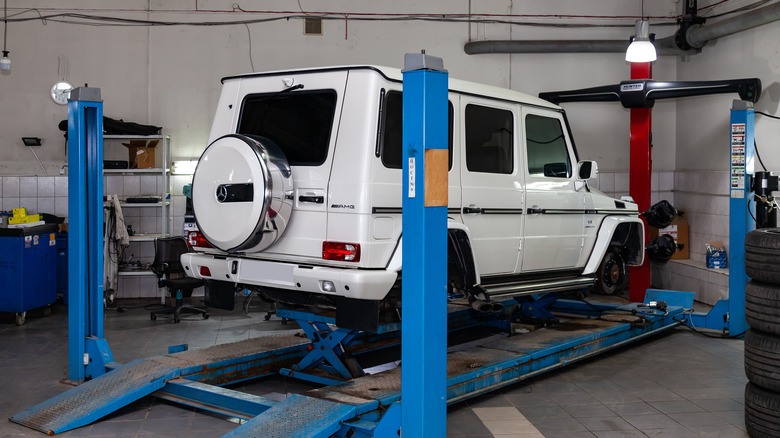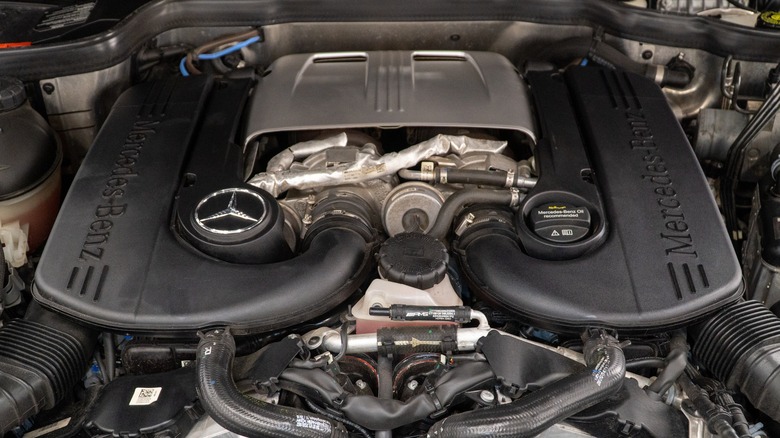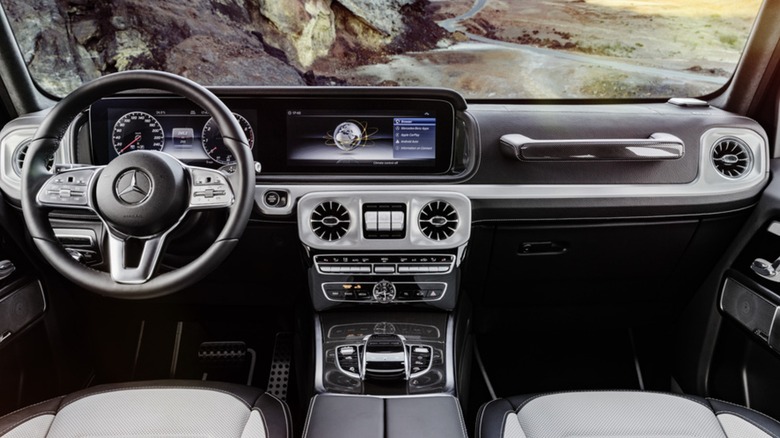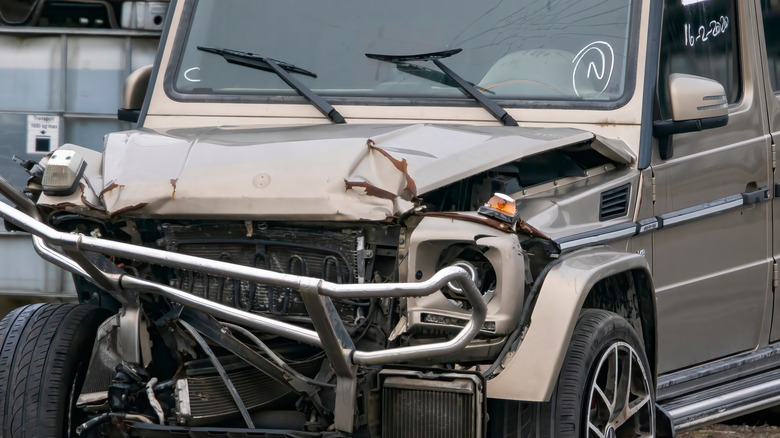
So, you’ve made up your mind about getting a pre-owned G-Wagen. Completely relatable — not many vehicles merge toughness, opulence, and prestige like the Mercedes-Benz’s square-shaped 4x4 does. This car really turns heads no matter where it cruises. And here’s the cherry on top: you won’t have to break the bank to get one. $140,000 for a basic version of the G-Wagon (Or a staggering $200,000 for a top-of-the-line AMG version) to enjoy the complete G-class experience. Opting for a carefully selected pre-owned model could shave off at least $50,000 from the price tag without compromising the exhilaration.
These vehicles go beyond typical SUV offerings. A G-wagon represents top-tier German engineering; thus, when they perform well, their reputation soars to legend status, but conversely, poor performance can lead to significant financial losses. Each truck comes with tales attached—think celebrities' prized possessions alongside those with questionable histories involving rough off-roading and minimal upkeep. It’s up to you to ensure you’re taking over one with an appropriate backstory.
Luckily, this guide is available to assist you. To prevent investing in a $100,000 project car, consider these 10 crucial aspects to inspect before purchasing a pre-owned G-wagon.
Read more: 5 of the Most Awesome Cars from American Graffiti
What Pre-Owned G-Wagen Model Year Suits You Best?

Not all Mercedes G-Wagon generations Are crafted equally. Absolutely, each one boasts that iconic, robust design along with several locking differentials. However, throughout the decades, Mercedes continuously refined their approach. For those who genuinely believe, without sarcasm, “They just don’t build ‘em as they once did,” the 1980s and early 1990s models will resonate deeply. These particular G-Wagons feature vinyl interiors, manual windows, and offer such an authentic driving experience that you can sense even small stones beneath the wheels—making them ideal for rugged terrain.
If you desire a G-Wagen that remains robust but doesn’t skimp on features such as air conditioning and a smooth ride on the highway, then consider the late '90s and early 2000s models. These vehicles boast more luxurious interiors, proper acoustic insulation, and even the initial AMG editions for those who wish their all-terrain vehicle could also outpace sports cars. Alternatively, look at the period from 2012 to 2018—this era offers an ideal balance between contemporary technology and classic design. The bi-turbo V8 and V12 AMG configurations ensure these wagons provide thrilling performance.
If budget isn’t a concern, then going for the 2019 and newer models would be akin to getting your hands on something nearly as prestigious as a genuine G-Wagon. These vehicles maintain their classic silhouette paired with a powerful dual-turbo engine as part of the standard package. Inside, they offer a cabin reminiscent of an S-Class, complete with luxurious comforts. Their suspensions are also designed for smooth rides. While exceptional, such features come at a steep price tag. Additionally, these cars tend to lose value rapidly—think along the lines of a high-end vehicle that devalues quickly despite its speed and luxury status.
Are You Purchasing for Pleasure or Potential as a Collectible in the Future?

Many individuals do not acquire a G-Wagon out of sheer practical necessity. The motivation typically stems from the exhilaration derived from operating a massive automotive behemoth, or alternatively, they anticipate their investment appreciating over time with hopes of it becoming a high-value collector’s item someday.
If you really love the thrill of driving, you have choices. The basic G550 model is more than adequate (and continues to draw attention), yet why limit yourself? Models such as the AMG G63 Turn up the craziness with 577 horsepower, 627 lb-ft of torque, and a nine-speed automatic transmission channeling all this power to the wheels. Furthermore, aftermarket tuning companies such as Brabus, Carlsson, Lorinser, and RENNtech step in to push these vehicles beyond their limits, making them even more exhilarating.
However, perhaps you’re considering this from an investor’s perspective. If so, special editions are where the profits lie. Think about limited-run AMGs, such as six-wheeled G63 6x6 For vehicles like the G650 Landaulet, substantial sums are being commanded in the collectors' market. Additionally, do not overlook the Puch-manufactured G-Wagons, such as the 1993 500 GE. However, there’s a caveat—these exclusive collectibles frequently gather dust in temperature-regulated storage facilities, seeing minimal use since each kilometer diminishes their worth. Ultimately, you must determine whether your priority lies in immediate excitement or future gains.
What Secrets Are Concealed Within the Maintenance Logs?

Consider a G-Wagon’s maintenance logs as its car history book. These documents offer insight into the vehicle's background, possibly uncovering hidden issues that might spare you expensive surprises down the line. If you’re thinking about buying a pre-owned G-Wagon, reviewing these records personally is essential.
Begin by looking for indications of lack of care. For vehicles from before 2018, oil changes ought to occur regularly every 5,000 to 7,500 miles. Models produced after 2018 may extend this interval up to 10,000 miles, provided they use high-quality synthetic oil. Regular upkeep such as replacing brake fluid, swapping out spark plugs, and servicing transmissions along with their filters should adhere strictly to Mercedes’ guidelines based on the specific model year and trim level. Should these fundamental tasks have been neglected, one must wonder about what additional services could also be overdue.
Next, pay attention to significant maintenance work. Items such as rebuilt transmissions, replaced turbos, or complete suspension upgrades deserve careful consideration. Large-scale repairs like these can provide insights into the car’s usage history—whether it has been handled with care or subjected to extreme conditions. While substantial repairs aren’t necessarily negative indicators, they should prompt you to seek additional information.
Preferably, you'd like to have a folder containing complete dealer invoices for maintenance and repairs. However, a thoroughly documented service record from a reliable independent Mercedes shop would also suffice. If the documentation consists merely of hasty notes on napkins, it’s best to decline. And if there isn’t any paper trail whatsoever, expect the worse and continue your search.
Is That G-Wagen's Powerful Smoothness Still Intact?

A properly maintained G-Wagen ought to roar to life confidently, rather than start weakly like an exhausted saloon car. Ensure it retains that “Whoa, this vehicle means serious business” vibe. This can be gauged from its initial morning ignition. If the owner refuses to allow you to initiate the engine-start yourself, consider that a stark warning sign flapping vigorously in caution.
Start your inspection of the engine by removing the dipstick. To ensure the oil is amber (not black). And ensure it’s at the appropriate level. Also check the coolant tank; if it appears low or dirty, the engine might have overheated. Next, perform a cold-start test—the engine ought to respond with a powerful, assured rumble, particularly if it’s an AMG variant. Should it seem as though it’s having difficulty idling steadily, it would be wise to leave.
As soon as you hit the road, listen carefully. Clattering or banging sounds may indicate costly problems with the valve train or timing chain. A shrieking noise during acceleration could signal impending troubles with the turbocharger or transmission. The exhaust should produce a clear and powerful sound; otherwise, something isn’t right.
Once you return from the test drive, park on a clear section of pavement to inspect for any leaks — this is the traditional method used for German cars. Small oil stains could be typical for vehicles with high mileage, but new signs of coolant or strange multicolored pools should raise concerns and may require reconsideration.
Is Everything with the Technology Functioning as It Should Be?

Don't let the tough exterior fool you -- a G-Wagon is loaded with tech. Unless you're going way back to the early years, you'll find features like rain-sensing wipers, heated power seats, and a 6.5-inch high-res screen running the COMAND system. Of course, those premium features don't mean much if they've stopped doing their job.
Before finalizing any documents, act like a detective and thoroughly test all the features and controls. Begin with the comfortable aspects. Do the heated seats really provide warmth? Is the air conditioning genuinely chilly when needed? Press each button, turn every dial, and ensure everything functions as intended. You wouldn’t want to discover issues with the heating or cooling systems during severe weather conditions.
Next up, let’s dive into the enjoyable part: testing the infotainment system. Is the touchscreen just as responsive as a top-of-the-line smartphone, or do you notice delays when using it? Can you play your preferred music tracks seamlessly without encountering any audio distortions from the speakers? And does the GPS accurately pinpoint your location? Go ahead and check everything since a malfunctioning infotainment setup could transform an otherwise thrilling journey into quite an unpleasant experience.
Make sure to inspect even the small details. Can you raise and lower the windows effortlessly? Do the mirrors function correctly? Are all the lights operational? A minor problem with a lightbulb could indicate larger issues within the vehicle’s electrical system.
Have you checked all the usual spots where G-Wagens usually corrode?

Despite its robust build, even the powerful G-Wagon can succumb to rust, particularly when overlooked post-purchase. While these vehicles are designed with durability in mind, factors like prolonged exposure to elements and de-icing salts over time will take their toll. Fortunately, identifying signs of deterioration becomes straightforward once you're aware of key inspection areas.
The first inspection point should be the undercarriage. Some surface rust is expected for a truck that has seen real use, however, if you notice peeling sections or signs of corrosion like small holes, this could indicate significant issues—prompting either an immediate exit from the deal or perhaps necessitating further investigation. Mercedes G-Wagon alternatives Pay particular notice to the frame rails where they bend upward towards the wheels, since these tend to corrode internally.
Go ahead and slide your fingers across the windshield frame beneath the rubber seals. Ta-da! Should they turn an unexpected shade of orange, consider this as a sign of potentially costly window replacements coming up. Move on to inspecting the door sills now. Gently lift the edge of these rubber seals slightly and search for signs of blistered paint underneath. Don’t forget about checking out the condition of the door hinges. Lastly, examine the area around the rear wheels; dirt and corrosive salts often accumulate here unnoticed. In case it appears scratched up similar to what might happen when using a box grater, brace yourself for some hefty repair costs down the line.
Do You Have Any Signs of Wear From Off-Road Usage?

The The "G" in G-Wagon represents Geländewagen. -- German for off-road truck — these vehicles were designed to tackle harsh landscapes. This implies that the pre-owned model you’re considering may have had quite an adventurous past. Crawl under and examine closely to uncover the signs of its journey.
The skid plates ought to exhibit signs of protection rather than severe scratches caused by struggles against rocks. New marks on the differential casings indicate either active use or extreme misuse of your G-class vehicle. The state of the suspension system can tell you much about the SUV’s previous escapades. Look out for leaks in the shock absorbers or any dented parts. Assess the status of the control arms and bushings as well. Spotting bright, newly installed bolts on aged control arms signals potential collision repair work.
Look past just checking the vehicle thoroughly; conduct a brief test instead. Locate some scattered pebbles and activate all three differentials — start with the central one, followed by the rear, and finally the front. They ought to lock smoothly without delay. Delayed response, unusual grinding sounds, or warning indicators on the dashboard indicate potential costly fixes ahead. Should the seller enthusiastically display their dirt-encrusted underside yet insist they have “never engaged the diff locks,” this typically means these components are stuck due to lack of use.
Can Past Repair Work On Your Vehicle Return to Cause Trouble?

A spotless CarFax does not ensure an impeccable history, although it certainly won’t harm to review it. In reality, such cars usually cost so much that they aren't written off as totaled; thus, a previously wrecked G-Class might simply be repaired and resold with only a small damage entry noted.
So, How can you determine if a vehicle has been involved in a collision? By starting with the panel gap police game, you can begin your inspection. Mercedes crafts these vehicles using precise German engineering; thus, inconsistent gaps between body parts often indicate prior repairs. Should the doors fail to produce their characteristic closing sound or if the hood appears misaligned, it’s time to take notice.
Next, examine the paint job. Original high-end cars usually have impeccable finishing, so if you notice an orange-peel effect, overspray around the rubber seals, or inconsistencies in panel colors, it could indicate cheaper repair work has been done. Additionally, pay attention to how the seller reacts; if they start exhibiting signs of unease specifically during your inspection of areas like the radiator support, it may be wise to look at another vehicle instead—perhaps someone else’s G-Class wagon.
If you think something fishy might be going on, reach out to your nearby Mercedes dealership. They frequently have access to concealed records such as dealer repairs and warranty activities that aren’t reflected on CarFax.
Are You Prepared for the Expenses of Buying a Pre-Owned G-Wagen?

Having a G-Wagen is akin to getting a high-end, pricey pet. While you might be purchasing it pre-owned, this isn’t your typical budget-friendly SUV—you can’t cut corners with maintenance and expect everything to run smoothly. As soon as that emblematic three-pointed star graces your driveway, consider your bank account officially put on alert.
To start, we'll address maintenance. A pre-owned G-Wagen still demands to be handled with utmost care when dealing with dealerships. As stated Edmunds' For a 2020 AMG G-Wagen, anticipate spending around $1,500 yearly for regular maintenance. If basic repairs are needed, tack on an additional $1,600 to $4,000 per year to your expenses.
Next up is insurance. When insurers come across "Mercedes," "capable off-road," and "costly repairs," they instantly worry about losing money. Consequently, expect to shell out a minimum of $1,400 each year based on factors like your age, where you live, and whether you have a history of speeding tickets.
In conclusion, let’s address the issue with fuel. This heavy vehicle consumes high-octane gasoline and manages only 13 to 15 miles per gallon even under ideal conditions. Now, how much will this amount to financially? Approximately $5,000 each year based on driving roughly 15,000 miles. Are you concerned about ongoing expenses like maintenance, insurance, and fuel costs? Get ready because after factoring in financing, taxes, fees, and depreciation, Edmunds calculates the total ownership expense to be close to $150,000. You might see it as an extra fee for enjoying something truly impressive.
Will Your G-Wagen depreciate like a rock or hold steady?

Depreciation is the sneaky drain on your wallet that gradually diminishes your car’s worth annually. Though you might overlook this fact most of the time, selling your pre-owned G-Wagon forces you to confront it head-on. Therefore, the main query remains — can your sturdy gem maintain its resale value, or will it drop drastically?
The stark reality? The 2025 G 550 will likely depreciate by roughly fifty percent over five years, as predicted. CarEdge Ouch, but hold off on panicking because here’s something to think about — yours is actually performing better than most other high-end SUVs. Your neighbor's Range Rover? Its value is dropping faster than a sinking ship next to your G-Wagen’s stability. CarEdge projecting that it will lose seventy-five percent of its value within the same timeframe.
Fortunately, not everything is lost. If you possess something genuinely exceptional, such as limited-edition Brabus G-Wagon If so, you’re definitely sitting pretty financially. Otherwise, be honest with yourself. This is more of a high-end plaything rather than a wise purchase. So now, relish that V8 engine sound and attempt to forget about the cost concerns.
Is Buying a Used G-Wagen a Good Idea?

You’ve done your research, so let’s get right down to it. Buying a pre-owned G-Wagen means signing up for a lifestyle with highly variable monthly costs that could easily surpass the original purchase price. The smart shopper—aka you—knows these vehicles hover in a gray area financially: part money sinkhole, part status symbol.
Once you discover the perfect match, an enchanting transformation occurs. Repair costs become more bearable. Fuel stops seem purposeful. Each ignition produces a deep-throated growl that drowns out all distractions. Is this enough to justify owning a pre-owned G-Wagon? That choice rests solely with you.
Should you choose to indulge in the complete G-Wagon experience, make sure of this much: you’ll take it off-road at least once. After all, that’s what it was made for, despite looking quite stunning even in the valet lane.
Interested in staying updated with the newest technology and automotive developments? Sign up for our complimentary e-newsletter. For the most recent news updates, detailed guides from experts, and practical advice delivered directly, all within a single email.
Read the original article on solusikaki.com .
